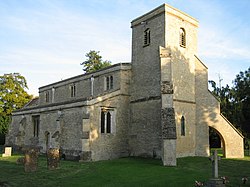Launton
| Launton | |
| Oxfordshire | |
|---|---|
 St Mary's, Launton | |
| Location | |
| Grid reference: | SP608225 |
| Location: | 51°53’53"N, 1°7’0"W |
| Data | |
| Population: | 1,204 (2011) |
| Post town: | Bicester |
| Postcode: | OX26 |
| Dialling code: | 01869 |
| Local Government | |
| Council: | Cherwell |
| Parliamentary constituency: |
Banbury |
| Website: | launton.org |
Launton is a village on the eastern outskirts of Bicester in Oxfordshire. The 2011 Census recorded the parish's population as 1,204.
Contents
History
In 1065, King Edward the Confessor granted the manor of Launton to his new foundation, Westminster Abbey, with whom it remained until the abbey was suppressed at the dissolution of the monasteries in 1540. The abbey lands were surrendered to the Crown, but in 1542 the Crown granted Launton to the Dean and Chapter of Westminster, now a royal peculiar. Queen Mary I recreated Westminster's monastic community and in 1556 she Launton to the Abbot; a situation reversed by Queen Elizabeth I in 1560. In 1649 the Parliamentary regime assigned Launton to Westminster School. In 1860 the lands of the Dean and Chapter of Westminster were vested in the Ecclesiastical Commissioners.[1]
The present manor house is 17th-century, with a court room that was re-ordered in the 19th century.[2] Its farmyard has a 14th- or 15th-century barn of 10 bays with 17th-century roof timbers. The barn may have been a tithe barn and now forms the centrepiece of a wedding venue called 'The Tythe Barn' after being restored in 1997.[3][4] It is now a Grade II* listed building.[5]
The Varsity Line between Bletchley and Oxford via Bicester Town was built through Launton parish and opened in 1851. Launton railway station served the village until the end of 1967, when British Railways withdrew passenger services between Bletchley and Oxford.
Church and chapels
Church of England
The Church of England parish church, St Mary's,[6] was built in the 12th century, and the four-bay aisles of its nave were added in the 13th century.[7][8] Sources disagree as to whether the west tower is part of the original 12th-century church or a 13th-century addition.[7] Originally the chancel had an apse, but in the 15th century this part of the church was reordered with a rectangular east end. The nave has a clerestory with 15th- or 16th-century windows.[8] Some of the windows of the aisles are 16th-century.[8][9]
In 1891 a pair of flying buttresses designed by Reginald Blomfield was added to the west tower. In 1910 an Arts and Crafts-style screen designed by John Oldrid Scott was added to the south aisle.
The church is a Grade I listed building.[8]
In the churchyard are the base and broken shaft of a 14th- or 15th-century stone churchyard cross.[10]
Presbyterian chapel
Launton had a Presbyterian congregation by 1772, when a meeting house was licensed for it. The congregation lapsed by about 1800, but was re-established by 1806. In 1807 Zion chapel was built for it on the western edge of the village. Later in the 19th century the chapel was used as a school.[1]
Congregational chapel
Bethel chapel was built in 1850 for an independent Nonconformist congregation. By 1855 it had a lending library and a school. It later joined the Congregational Church.[1][11]
Society and sport
Launton has two public houses: The Bull Inn at the crossroads in the centre of the village and The Launton Arms (formerly The Black Bull) at West End.[12]
There is a Parish Hall, and a Sports and Social Club, which provides the home pitch for the football club, plus a tennis court and small children's play area.[13]
- Amateur dramatics: The Launton Village Players, who perform an annual pantomime in Bicester, and musical shows and plays in the village
- Football: Launton Sports F.C.
- Tennis
The village has a Woods on your Doorstep[14] at Island Pond Wood, managed by The Woodland Trust. Villagers bought it by public subscription and planted it in 1999.[15]
Outside links
| ("Wikimedia Commons" has material about Launton) |
References
- ↑ 1.0 1.1 1.2 Lobel 1959, pp. 232–243
- ↑ National Heritage List 1232878: Manor Farmhouse (Grade II listing)
- ↑ "The Tythe Barn – Wedding Venue, Private Parties & Corporate Events" (in en-GB). https://www.thetythebarn.co.uk/.
- ↑ Rogers, Joseph (2021). Tithe barns. Stroud, Gloucestershire. pp. 85–86. ISBN 978-1-4456-9285-2. OCLC 1242784225. https://www.worldcat.org/oclc/1242784225.
- ↑ National Heritage List 1232879: Barn south of Manor Farmhouse (Grade II* listing)
- ↑ St Mary's, Launton: A Church Near You
- ↑ 7.0 7.1 Sherwood & Pevsner 1974, pp. 681.
- ↑ 8.0 8.1 8.2 8.3 National Heritage List 1369735: Church of St Mary (Grade I listing)
- ↑ Sherwood & Pevsner 1974, pp. 682.
- ↑ National Heritage List 1276857: Churchyard cross south of the Church of St Mary, Bicester Road (Grade II listing)
- ↑ "Launton". Oxfordshire Churches & Chapels. Brian Curtis. http://www.oxfordshirechurches.info/Launton.html.
- ↑ "Introducing the Launton Arms". https://info693713.wixsite.com/theblackbull.
- ↑ "Launton Sports and Social Club". Launton Village Website. 2010. http://launton.org/launton_sports_and_social_club.html.
- ↑ "Woods on your Doorstep". Projects. The Woodland Trust. 2010. http://www.woodlandtrust.org.uk/en/about-us/projects/woyd/pages/woyd-uk.aspx.
- ↑ Cite error: Invalid
<ref>tag; no text was provided for refs namedWoodlandTrust
- A History of the County of Oxford - Volume 6 pp 232-243: Parishes: Launton (Victoria County History)
- Marples, BJ (1973). "The Mediæval Crosses of Oxfordshire". Oxoniensia (Oxfordshire Architectural and Historical Society) XXXVIII: 299–311. SSN 0308-5562. http://oxoniensia.org/volumes/1973/marples.pdf.
- Nikolaus Pevsner: The Buildings of England: Oxfordshire, 1974 Penguin Books ISBN 978-0-300-09639-2
